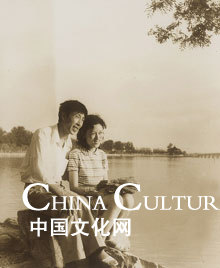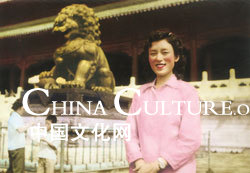30 Years of change in images
A three-storey photo studio seems a little lonely against the tall buildings and spacious mansions on the Shangzhi downtown street in Daoli District of Harbin. A neo-classical bronze medallion reading "Zhenmei Photo Studio, built in 1936" hangs at the entrance. Although the identity of the photographers has changed over the generations, the studio has always been dedicated to professional photography, according to the Heilongjiang Daily.
 |
|
Anyone would have envied photographer Chen Fengchun the opportunity to take photos using his own camera when travelling, as he did in the 1980s. [File photo] |
"We have no darkroom now -- that was a principal feature of film work in the past. Now my basic tools are digital cameras and computers," said young photographer Chen Xu, while skillfully altering children's photos at his computer. He cuts the existing background off a little fellow's photos, and replaces it with a computer-designed background of beautiful lawns and flowers. Another picture is quickly combined from two different poses of the youngster; once morphed, a lovely photo of a child is ready. "This is what I do, sitting here all day," he explains.
"It won't be easy to find old photographers nowadays, and if they come into the studio they will be confused to see such advanced facilities--computers, digital cameras and scanners... look at this old-fashioned camera, we haven't used it for years--it's just for display," said Chen Fengchun who is the head of "Zhenmei Photo Studio", a veteran of 30 years whose working life is as long as Chen Xu's whole life.
Chen Fengchun relishes talking of his "darkroom" of the past: "In the darkroom at that time, nothing was visible under the dark green light bulb. The film had to be washed entirely by hand; the length of exposure had to be planned exactly by touch..." Chen Xu, 30 years old, has been working at "Zhenmei Photo Studio" for 12 years. But compared with Chen Fengchun, he is still a novice. "I did not like the job when I first graduated, but I love it more as time goes by; I gain a great sense of accomplishment when I get a good photo after hard work and planning," said Chen Xu.
Chen Fengchun, 53 years old, arrived in the city from a farm in 1979. He first worked at the "North Photo Agency", and then in 1988 he moved to "Zhenmei Photo Studio" as the manager. Now he is president of the Zhenmei Photography Limited Ltd., Co.
At the very beginning of China's reform and opening-up, the camera industry ushered in a new generation of graduates from middle and high schools and brought them together with experienced masters invited by photography agencies to train the newcomers.
Chen Fengchun was assigned to the post-production workshop, where his duties included washing, developing, coloring, enlarging, revising, and cutting. Each process, he says, contained advanced technical skills unknown to outsiders. At that time, the young Chen Fengchun was full of a passion for everything. In the early 1980s, touring started to become a regular family pastime, and many families would spend their holidays in parks and by wild rivers, taking photos which brought prosperity to the state-owned photography industry with its growing quantities of processed films and busy staff.
Memories of the changing face of photography over the decades unfold as Chen Fengchun digs out his old family photos.
The China of the late 1970s was a land of black-and-white photos. "At that time, we could only add lace or write Chinese characters--later on enterprises, landscapes, and other graphics could be added to the margins of the photos. Colored photography was a fashion item--much more expensive than black and white, and therefore an unaffordable luxury for most people."
Chen Fengchun's pride and joy is a photo of a little girl holding a doll. Its uniqueness stems from two Chinese characters "folk" and "urban" at the bottom of the picture. They are in gold, instead of being applied by pen, which was popular later and became fashionable. It turns out that etching golden characters onto a photo was an invention of the young Chen Fengchun.
In the early 1980s, more and more young people swarmed into photo studios. Chen Fengchun recalled how every studio tried its best to advance as business boomed. He first carried out research in the darkroom. At that time, experienced veterans timed by feel when exposing films. In only a few months Chen had invented an electronic timer. It seemed a simple enough achievement to him, but at the time it caused a sensation. Without any formal technical training he also invented an electronic shutter by repeatedly dismantling old cameras.
"At that time, my elder brother worked in a stationery factory. One day he came home with a ball point pen with gilt characters, I had a brainwave: why not turn black-penned characters on the photos into golden ones?" Chen Fengchun recalls. This was easier said than done--it needed special gilt powder, a controlled temperature, and also a printing matrix. The fashionable photos finally appeared.
Chen Fengchun also went on to invent other things such as a flash umbrella. As a young man, his wages rose several times and a variety of honors were acquired in a regular stream...
Chen Fengchun's best work may be a series of photos taken with his wife on their honeymoon trip to Beijing. At that time, it was no trivial matter to be able to bring one's own camera and take photos as a memento in front of Tiananmen. On his return, Chen Fengchun colored his wife's photograph carefully: pink shirt, red lips, even the stone lions next to her were given a brassy sheen. But in the twinkling of an eye color film had arrived, and there was no further need for tinting photographs.
 |
|
Chen Fengchun himself colored this photo of his wife with pink shirt and red lips, taken in the early 1980s in Beijing. [File photo] |
The reporter was attracted by his 5-year-old son's birthday photo -- a handsome little boy smiling happily at table covered with fruits and cake. "In fact, the table is just a placard--we drew all the things on it." Chen Fengchun recalls how, in 1988, they produced the studio's backgrounds and props entirely by painting on board. They look very fake to the modern eye, but at that time it was all that was available.
















